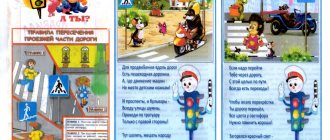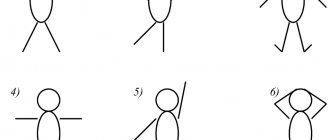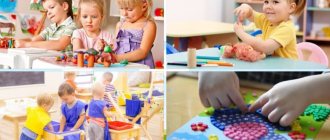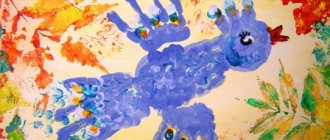Senior group. Senior preschool age. Children 5-6 years old
Summary of the parent meeting in the senior group on labor education Parent meeting in the senior group No. 10. Topic: “Labor education in the family and in preschool educational institutions”
.
Goal: to attract parents to the labor education of preschoolers. Objectives: Show parents the importance of labor education in the life of a preschooler.
Expand the presentation and enrich pedagogical ... KVN for parents of senior groups at the parent meeting Game-quiz “KVN”
With
parents of older groups Goal : To attract parents to practice mathematics with their children at home. Arouse interest in the game. Preliminary work: Conversations about playing the game, found material for KVN, invited parents to make math games at home with their children...
Reports to parent meetings, material on the topic
Report to the parent meeting
in older groups with OHP and mental retardation
"Psychological service in preschool educational institutions"
Conducted by: teacher-psychologist
T.V. Yatsenko
date: February 2013
Good evening, dear parents! We are glad to meet you. The children were worried and really looking forward to seeing you today. After all, they love you so much, are proud of you, and all of us who work with your children share their feelings and recognize: you truly are a worthy example for your children, an example of goodwill, politeness, punctuality and responsiveness. If you think about what will happen and who your child will become, if in a certain situation you do exactly this and not differently, then this is very good. And this means that you are creative parents. To help you parents, a psychological service has been created at the preschool educational institution.
What is psychological service in kindergarten? Who should it serve and why?
For emergencies, so as not to do anything stupid in the heat of the moment or due to lack of time. You know, it’s like providing first aid: I put a bandage on it and stopped the bleeding. And then, of course, radical help. If necessary, you will have to contact a specialist.
Don't be complex! Remember that all parents make mistakes because no one taught them how to be parents. But it’s important to see your mistakes and not harm the child, because being a mom and dad is a huge responsibility! How often do parents have questions about parenting? Daily? No, probably even more often. And many mothers and fathers find themselves alone with their problems. In fact, what to do if a child regularly throws tantrums? Nail biting? Or is he afraid of the dark?
You can consult with a friend. It is quite possible that she will suggest something from her own teaching experience. You can ask your mother or mother-in-law. After all, they raised you and your husband. And it seems to have worked out well. You can buy books or magazines for parents. Fortunately, there are now a great many such publications. And read, read, read...
And yet, every child is unique. Moreover, each situation is also unique. And parents should be aware of what problem they can cope with on their own, and what they still need to turn to a specialist for.
For some reason, there is some kind of warning that you should only go to a psychologist if the situation is completely critical. Like, we don’t need a psychologist, our child is normal, he’s just capricious, like everyone else.
But parents most often see only their child. A psychologist works with many children and, therefore, it is easier for him to see and compare the behavioral characteristics of your child with other children.
And then, does the parent undergo special training? No, he learns to educate from his own mistakes. And some of our mistakes and blunders pass without a trace for the child. But sometimes, when we make mistakes, we hurt a child, leaving a mark on his soul for many years. In order not to make mistakes, try to build your own pedagogy and you should contact a psychologist. A child psychologist will help you answer questions about children’s behavior, adjust your approach to the child, and come up with and suggest how best to act in a given situation.
And now I will ask you to fill out a questionnaire and find out what kind of parents you are and how you feel about your child, maybe you need to think about it and change or adjust the methods of raising your child. (Parents fill out the form - see Appendix No. 1)
One of the important tasks of a psychologist’s work in a kindergarten is the development of the child’s emotional sphere, teaching him adequate ways to express his own feelings. Sometimes children (and adults too) have a feeling when they want to be left alone. After being alone for some time, children more easily return to a normal state and quickly integrate into the normal life of the group. Some people get tired simply because they have been in the company of their peers for a long time.
By inviting the child to be alone or in the company of 2-3 children close to him in spirit, the adult lets the child understand that his feelings and condition are not indifferent to those around him. For this purpose, each group has privacy corners where the child can be alone or with one of his friends. This is just a corner separated by a screen from the general space.
In each age group of kindergarten there are children who are distinguished by emotional instability of behavior: some are excessively conflictual, others are very touchy, and others are simply aggressive. If one child quickly gets out of a negative state, then another has difficulty doing so. Being in a state of resentment, anger, and depression for a long time, the child experiences emotional discomfort and tension, and this is very harmful to mental and physical health. It is necessary to get him out of this state as quickly as possible.
When working with children, games and exercises are widely used to relieve psycho-emotional stress (see games in Appendix 2). In a play therapy room, a child who is sad can simply sit (lie down) on the sofa, hugging his favorite toy, and listen to calm music. To express feelings of anger, there are objects for beating - pillows that can be beaten with your hands, kicked with your feet, or thrown up. You can build a tower from foam cubes and then destroy it. In the drawing corner, a child will be able to relieve a negative state with the help of drawings and coloring.
And now a little about when you need to see a psychologist:
☺If the problem is not solved for a long time;
☺If you know how to solve the problem, but you still need help;
☺If something worries you about children’s behavior, but you cannot understand the reason;
☺If it seems to you that the child is lagging behind his peers in development. Most likely, this is what you think. But it’s better to dot all the i’s and not torment the child with comparisons with other children;
☺If you have family problems and this affects the child.
Thus, dear parents, a child psychologist will help you answer questions about child behavior, adjust your approach to the child, and tell you how best to act in a given situation. Therefore, we are waiting for you for individual consultations on Wednesdays from 17.00 to 18.40 in the psychologist’s office.
Thank you for attention! If you have any questions, we will be happy to answer them.
Bibliography:
1. Aralova M. A. Directory of a preschool educational institution psychologist. – M.: TC Sfera, 2010. – 272 p. – (Education reference books).
2. Chub N.V. Handbook for parents. Child psychology from A to Z / Khud.E. A. Martynenko. - Kh.: Ed. group “Osnova”, 2007. – 160 p. – (Series: “For caring parents”).
3. Yakovleva N. Psychological assistance to preschoolers: A book for parents and educators. – St. Petersburg: Valeri, 2001. – 112 p.
Internet resources:
1. https://www.7ya.ru/
2. https://www.mama.ru/
3. https://www.materinstvo.ru/
Appendix 2
Recommended games and exercises will help children relieve negative states and negative emotions, establish relationships, and learn to understand each other.
ROUND EARED
Glue a circle with ears on the wall (shield). Children who have been offended or angered by someone can throw a ball at the “eared boy”, representing their offender. Thus, the negative state is removed.
TENDER PALM
Children stand in a circle, one after another. They stroke the child standing in front with their palms (mom, dad on the head, back, outer part of the arms (lightly, lightly touching). This exercise relieves tension and relaxes.
Bindweed
The exercise is performed in pairs. One of the children, lightly fingering his hands, “climbs” the other child’s back from bottom to top (the bindweed grows, stretches upward). The exercise relieves tension and calms the child. Note: before performing this and the previous exercises, it is necessary to draw the children’s attention to how to stroke, how to touch with fingers (show exactly how this should be done).
GRULER REWINDING
Two balls of different colors with a diameter of approximately 5 cm, secured so that the threads do not unwind, are connected to each other by a thick thread of yarn 1–1.5 m long. The child rewinds the thread from one ball to another. You can have several of these sets: the wound thread can be of different colors, lengths and thicknesses. The exercise perfectly relieves stress and develops fine motor skills.
CLAP - STOMP
Invite one or more children who are experiencing psycho-emotional stress or feelings of anger to perform simple movements - stomping their feet, clapping their hands as hard as anyone likes. You need to perform the exercise in a specially designated corner.
DESTROYERS
Together with the children, build a fortress (tower, wall) from cardboard cubes (the cubes can be glued and painted food and perfume boxes). Then the children destroy this fortress by throwing balls at it. The exercise is performed as long as there is a desire to build and destroy.
SECRETS
Sew small bags (about 10 x 15 cm) of the same color. Pour various grains into them (do not stuff them tightly) - semolina, rice, peas, beans, buckwheat, etc. Invite children experiencing emotional discomfort to guess what is in the bags? Children crumple the bags in their hands and switch to another activity, thus escaping the negative state.
TORN PAPER
Children tear paper (old newspapers, other unnecessary paper) into small pieces and put it all in a large pile. Then you can sprinkle this paper on each other and throw it up. First, you need to agree with the children that after scattering, we will all collect pieces of paper together and wash our hands.
Knead the dough
Manipulating the test perfectly relieves psycho-emotional stress and develops motor skills. Children simply crush it in their hands, knead it, and, if desired, can sculpt various figures from it. Children can play with the dough in a private corner, together or alone. Dough recipe: 2 cups flour, 1 cup salt, 1 cup water tinted with food coloring, 2 tablespoons vegetable oil. This dough can be stored for a long time in the refrigerator in a plastic bag. If it dries out, you need to add a little water and knead it well.
FURRY DRAWINGS
Glue a piece of faux fur (not very short and thick) onto a thick base - cardboard, plywood. The child draws various objects on the fur with his finger. This exercise calms the child and relieves tension.
BUBBLE
Children become soap bubbles. To the words of the presenter, who imitates blowing soap bubbles, children perform various movements. Watch out for bubbles! Oh, what! Oh look! They're getting bloated! They sparkle! They're having a blast! They're flying! And they burst! Soap bubbles burst (clap your hands). Children fall on the carpet, relax, rest for a while. The exercise is repeated.
CHAMBER BEETLES
May bug children. They fly and buzz to the words of the presenter. The beetles lie on the carpet with their legs up and flounder. Tired. They lie there for a while, relaxing to the sound background in a forest clearing. The exercise can be repeated 2-3 times depending on the wishes of the children.
May beetles are flying in a clearing by the river. They lay on their backs, their legs dangling. They became quiet. They're falling, they're tired! They are resting.
Parent meetings in kindergarten - Parent meeting in the senior group “The Basics of Education”
Publication “Parents meeting in the senior group “Azy...” Preparation for the meeting. 1. Conduct a survey: (Appendix 1) 2. Memos for parents: “Secrets of raising a polite child” (Appendix 2) 3. Invitations to each family to the meeting (Appendix 3) 4. Presentation Progress of the meeting. Introductory speech against the background of music. Good evening,…
Master class for parents “Development of voluntary self-regulation in older preschoolers” Goal: Increasing psychological competence and developing practical skills of parents on this topic. Objectives: • Establish partnerships with parents of preschool children; • Create an atmosphere of mutual understanding, community of interests, emotional mutual support; •…
Parent meeting for parents of older preschoolers “The influence of fiction on the moral development of children” “The influence of fiction on the moral education of children” Until recently, the value of books and reading in our country was undeniable. In the 1970-1980s, a myth arose about Russia as the most “reading country in the world.” The high prestige of reading in society, and especially “serious”...
Summary of the parent meeting in the senior group “Children’s questions and how to answer them” Topic. “Children’s questions and how to answer them” Goal: - attracting parents’ attention to children’s curiosity as an important personality quality. - to form the need to competently answer children’s questions, without suppressing the manifestation of children’s initiative and curiosity. -...
Report “Interaction with parents in preschool educational institutions”
Municipal budgetary preschool educational institution "Kindergarten No. 283 "Golden Key"
Report
“Interaction with parents in preschool educational institutions”
Prepared
teacher
Slastnikova M.A.
Nizhny Novgorod
Family and kindergarten are two educational phenomena, each of which gives the child social experience in its own way, but only in combination with each other do they create optimal conditions for a little person to enter the big world. To ensure favorable living conditions and upbringing of a child, the formation of the foundations of a full-fledged, harmonious personality, it is necessary to strengthen and develop close connections and interaction between the kindergarten and the family. Interaction, as a social partnership, implies equal participation in the upbringing of the child, both the kindergarten and the family. Creating a unified space for the development of a child, eliminating the contradictions between family education and upbringing in preschool educational institutions, is the key to solving many problems facing pedagogy.
The goal and objectives facing the family and kindergarten are the same: to raise healthy, comprehensively developed people.
Establishing partnerships between a preschool educational institution and parents is very important, since the family and kindergarten, having their own special functions, cannot replace each other. Social partnership is one of the ways to socialize children, facilitating the painless introduction of our pupils into public life, “Socium”. . The process of socialization of a child is more successful when positive relationships are established with parents and the public, with the goal of creating a unified space for the child’s social development; a new type of partnership has been built not only between children and teachers, but also between teachers and parents on the basis of a friendly, trusting relationship; The pedagogical knowledge of parents on interaction with children has been expanded; a system of interaction between preschool educational institutions and sociocultural objects has been organized to expand the educational space.
Of course, it’s good when a child grows up in a family where they listen to Mozart and Bach, there is a musical instrument in the house that the parents play, and where the baby is sung lullabies before bed. There are very few such families. In kindergarten, I encourage children to listen to music, “bathe” in it, show creative imagination, improvise, sing, dance, and instill cultural and aesthetic values. And at home, the child inevitably hears what the adults are playing. I try to teach my parents to use the wonderful power of musical art. Parents make many mistakes out of ignorance; here, the help of a kindergarten is simply necessary. Parents should not assume that musical education in kindergarten applies only to children and consists of conducting classes, organizing holidays and entertainment. I try to ensure that moms and dads are aware of individual work, the topics of music classes, program areas and requirements, have an idea about various types of musical activities, music clubs, ongoing projects, etc. I believe that it is important to interest parents in working in a kindergarten, to show what a kindergarten can do for their children, and to explain the need for close cooperation. When preparing to cooperate with a family, I think through the forms and methods of work and ensure that they comply with the assigned tasks and the characteristics of the intended interaction partners. I try to involve parents in the educational process, awaken their interest in the life of children in a preschool institution, and intensify participation in various events.
Summary of the parent meeting in the middle group on the topic: “Let's get to know each other!”
Dear parents, I would like to introduce you to the daily routine in our group and ask you to follow it. Acceptance of children up to 8. . Our morning exercises start at 8:00, so I ask you to bring your children before 8:00 – 8:00. Then there is breakfast and classes begin. If you are late and arrive during class, wait until the class ends... Familiarize yourself with the rules for visiting the preschool educational institution
.
For music and physical education classes, a uniform and shoes are required.
Get acquainted with the network of classes
Organized activities for children are carried out in the following educational areas:
“Cognitive development” - develop interest in the world around us, form ideas about objects, their characteristics and the materials from which they are made; generalize knowledge about public transport; about traffic rules; about your hometown (city name, home address); we will introduce you to indoor plants, trees, fruits, berries, mushrooms, birds, insects, wild and domestic animals, birds; sequence of seasons.
We will develop knowledge about geometric shapes, study the number series, solve logical problems and much more.
“Speech development” - be able to name words that begin with a certain sound; coordinate words in a sentence, understanding their meaning; the ability to describe objects and toys; tell from the picture; write short stories.
“Social and communicative development” - to form a caring attitude towards your family, towards kindergarten, towards your hometown (village); develop a child’s positive attitude towards himself, his peers, adults and the world around him.
“Artistic and aesthetic development” - develop children’s ability to listen to works of different genres and themes (fairy tales, stories, poems), involve children in predicting familiar works, memorizing poems, proverbs, sayings;
Develop interest in visual arts. Reinforce the techniques of painting with gouache paints, introduce them to the features of working with watercolors. Improve the ability to draw lines and rings with the entire bristle of the brush, and also learn to draw dots, lines, and rings with the end of the brush. Learn to draw a circle.
“Physical development” - consolidate skills in basic types of movements and enrich the child’s motor experience; develop physical qualities: speed, endurance, agility, etc.; develop organization, independence, and initiative in children.
Familiarizing parents with the goals and objectives of the preschool educational institution for the new school year.
Educational activities correspond to the approximate basic educational program of preschool education “Mosaic Park”,
according to which our kindergarten operates. Developed in accordance with the requirements of the Federal State Educational Standard for Preschool Education (FSES DO), approved by the Order of the Ministry of Education and Science of the Russian Federation dated October 17, 2013, Moscow, edited by Victoria Yuryevna Belkovich, Natalya Valentinovna Grebenkina.




